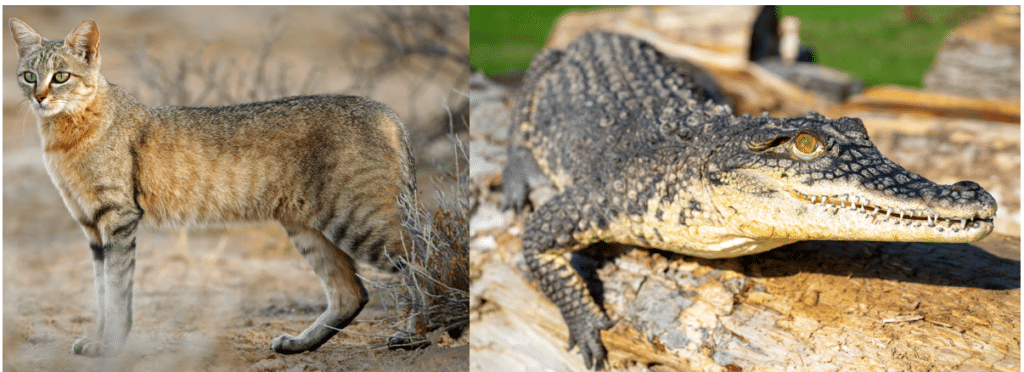3 Fierce PREDATORS found in the Ivory Coast! (2025)
What are the different kinds of PREDATORS found in the Ivory Coast?

These are often the first animals you think of when you imagine visiting the Ivory Coast! The exciting, beautiful, and sometimes terrifying carnivores are some of the most fun to learn about. 🙂
In this article, you’ll find interesting facts, photos, and even range maps of these amazing animals!
3 Predators Found in the Ivory Coast:
#1. Honey Badger
- Mellivora capensis

Identifying Characteristics:
- Adults are 55–77 cm (22–30 in) long.
- They have stocky bodies, large heads, small eyes, strong, wide forefeet, small hind feet with short claws, muscular necks and shoulders, and thick, loose skin.
- Their color varies with subspecies, but generally, their lower half is black, and they have an upper mantle of gray or bright white.
Honey Badgers are one of the toughest carnivores in the Ivory Coast!
They have a reputation for being able to live anywhere, eat anything, and survive no matter what. Look for these resourceful creatures in forests, grasslands, woodlands, deserts, rocky hills, and arid steppes. You’re likely to find them near sheltered spots like burrows and rock crevices.
Their diet is as varied as their habitat. Honey Badgers are opportunistic foragers whose menu changes with the season and prey availability. They frequently prey on snakes, birds, eggs, frogs, and small rodents.
As their name suggests, they’re also known for raiding honey bee hives to eat the larvae and honey inside. While they are primarily carnivores, Honey Badgers also enjoy fruits, roots, and bulbs.
Honey Badgers are known for their aggressive nature. Males will ferociously defend their territory and mate from other males. Naturalists sometimes refer to older adult males as “scar backs” because they usually have a noticeable patch of scars on their backs from conflicts.
The video below is one of my favorites and shows how TOUGH Honey Badgers are! Seriously, you have to watch until the end.

#2. African Civet
- Civettictis civetta

Identifying Characteristics:
- Adults are 67–84 cm (26–33 in), with a 34–47 cm (13–19 in) long tail.
- They have large hindquarters, low heads, and short manes that extend down their backs.
- Coloration is silverish or cream with black or brown markings and spots, a black raccoon-like face mask, and white neck stripes.
If you see this predator in the Ivory Coast, you might not know exactly what you’re looking at!
African Civets are incredibly unique. They have some similar features to raccoons and cats but aren’t related to either. Their large hindquarters and extended mane are dead giveaways that you have found an African Civet.
These unusual-looking animals will live in both forested and open areas, but they need plenty of cover for hunting and hiding from larger animals. For example, in open areas, they require tall stands of grasses or thickets to shelter in during the daytime.
African Civets are primarily nocturnal but occasionally move around during the morning or evening of cloudy days. They’re secretive and solitary except when they come together to breed.
Despite being a relatively shy animal, they can become a nuisance to farmers. Occasionally, they go after poultry and young lambs. When catching live prey, they overpower it with their teeth rather than their paws.
#3. African Clawless Otter
- Aonyx capensis

Identifying Characteristics:
- Adults are 113–163 cm (44–64 in) long.
- They have large heads, stout, tapered tails, partially webbed hind feet, long white whiskers on their cheeks, chin, and brows, and are clawless except for three grooming claws on each hind foot.
- They have thick, shiny dark brown coats with white markings on their upper lips, the sides of their faces, necks, throats, bellies, and lower ears.
These predators are the largest otters in the Ivory Coast!
As a primarily aquatic species, you’ll almost always see African Clawless Otters around rivers and springs. They prefer areas with thick reed beds and shallow water because they don’t dive below 1.5 m (5 ft).
African Clawless Otters also spend time on land. They build dens with entrances above or below the water that they share with other otters. They use their dens for giving birth, playing, eating, and resting.
These carnivores breed during the dry season, and the young otters are particularly fun to watch. They spend much of their time fighting, swimming, sliding on rocks, playing with their food, and throwing pebbles into the water to dive and grab before they reach the bottom. Watching them is like a little circus show!
Check out these other guides about animals found in the Ivory Coast!
-
50 Most Common Animals Found in the Ivory Coast!
-
The 15 MOST Common Birds in the Ivory Coast!
-
The 7 Types of Snakes That Live in the Ivory Coast! (ID Guide)
-
2 COMMON Spiders found in the Ivory Coast!
Which of these predators have you seen before in the Ivory Coast?
Leave a comment below!




